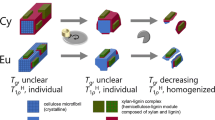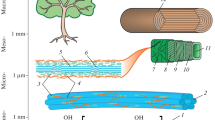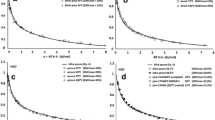Abstract
The heat capacity of wood and its constituents is important for the correct evaluation of many of their thermodynamic properties, including heat exchange involved in sorption of water. In this study, the dry state heat capacity of cellulose, hemicelluloses and lignin are mathematically described by fundamental physical theories relating heat capacity with molecular vibrations. Based on knowledge about chemical structure and molecular vibrations derived from infrared and Raman spectroscopy, heat capacities are calculated and compared with experimental data from literature for a range of bio- and wood polymers in the temperature range 5–370 K. A very close correspondence between experimental and calculated results is observed, illustrating the possibility of linking macroscopic thermodynamic properties with their physical nano-scale origin.








Similar content being viewed by others
References
Steinhagen HP (1977) Thermal conductive properties of wood, green or dry, from −40 °C to 100 °C—a literature review. General technical report FPL-9, USDA Forest Service, Madison, WI
Hatakeyama T, Nakamura K, Hatakeyama H (1982) Studies on heat-capacity of cellulose and lignin by differential scanning calorimetry. Polymer 23:1801–1804
Karachevtsev VG, Kozlov NA (1974) Study of thermodynamic properties of cellulose at low-temperatures. Vysokomol Soedin Ser A 16:1892–1897
Pyda M (2002) Conformational heat capacity of interacting systems of polymer and water. Macromolecules 35:4009–4016. doi:10.1021/ma0118466
Pyda M, Bartkowiak M, Wunderlich B (1998) Computation of heat capacities of solids using a general Tarasov equation. J Therm Anal Calorim 52:631–656. doi:10.1023/a:1010188110516
Wunderlich B (1997) The heat capacity of polymers. Thermochim Acta 300:43–65. doi:10.1016/s0040-6031(96)03126-7
Wunderlich B (1995) The ATHAS database on heat-capacities of polymers. Pure Appl Chem 67:1019–1026. doi:10.1351/pac199567061019
Einstein A (1906) The Planck theory of radiation and the theory of specific heat. Ann Phys Berlin 22:180–190
Blackman M (1941) The theory of the specific heat of solids. Rep Prog Phys 8:11–30
Debye P (1912) The theory of specific warmth. Ann Phys Berlin 39:789–839
Sallamie N, Shaw JM (2005) Heat capacity prediction for polynuclear aromatic solids using vibration spectra. Fluid Phase Equilib 237:100–110. doi:10.1016/j.fluid.2005.07.022
Tarasov VV (1952) Metasilicate chains and the theory of thermal capacity. Dokl Akad Nauk SSSR 84:321–324
Nernst W, Lindemann FA (1911) Specific heat and quantum theory. Z Elektrochem Angew P 17:817–827
Pan R, Nair MV, Wunderlich B (1989) On the c p to c v conversion of solid linear macromolecules II. J Therm Anal 35:955–966. doi:10.1007/bf02057252
Pyda M, Wunderlich B (1999) Computation of heat capacities of liquid polymers. Macromolecules 32:2044–2050. doi:10.1021/ma9816620
Loufakis K, Wunderlich B (1988) Computation of heat-capacity of liquid macromolecules based on a statistical mechanical approximation. J Phys Chem 92:4205–4209. doi:10.1021/j100325a042
O’Reilly JM (1977) Conformational specific heat of polymers. J Appl Phys 48:4043–4048. doi:10.1063/1.323444
Sjöström E (1993) Wood chemistry—fundamentals and applications, 2nd edn. Academic Press, San Diego, p 293
Di Lorenzo ML, Zhang G, Pyda M, Lebedev BV, Wunderlich B (1999) Heat capacity of solid-state biopolymers by thermal analysis. J Polym Sci Pol Phys 37:2093–2102. doi:10.1002/(sici)1099-0488(19990815)37:16<2093:aid-polb12>3.0.co;2-2
Uryash VF, Rabinovich IB, Mochalov AN, Khlyustova TB (1985) Thermal and calorimetric analysis of cellulose, its derives and their mixtures with plasticizers. Thermochim Acta 93:409–412. doi:10.1016/0040-6031(85)85103-0
Pyda M (2001) Conformational contribution to the heat capacity of the starch and water system. J Polym Sci Pol Phys 39:3038–3054. doi:10.1002/polb.10060
Kaminski K, Kaminska E, Ngai KL, Paluch M, Wlodarczyk P, Kasprzycka A, Szeja W (2009) Identifying the origins of two secondary relaxations in polysaccharides. J Phys Chem B 113:10088–10096
Jafarpour G, Dantras E, Boudet A, Lacabanne C (2008) Molecular mobility of poplar cell wall polymers studied by dielectric techniques. J Noncryst Solids 354:3207–3214
Roig F, Dantras E, Grima-Pettenatti J, Lacabanne C (2012) Analysis of gene mutation in plant cell wall by dielectric relaxation. J Phys D Appl Phys 45. doi:10.1088/0022-3727/45/29/295402
Montes H, Mazeau K, Cavaille JY (1997) Secondary mechanical relaxations in amorphous cellulose. Macromolecules 30:6977–6984
Montes H, Cavaille JY (1999) Secondary dielectric relaxations in dried amorphous cellulose and dextran. Polymer 40:2649–2657
Montes H, Mazeau K, Cavaille JY (1998) The mechanical beta relaxation in amorphous cellulose. J Noncryst Solids 235:416–421. doi:10.1016/s0022-3093(98)00600-0
Einfeldt J, Meissner D, Kwasniewski A (2004) Molecular interpretation of the main relaxations found in dielectric spectra of cellulose—experimental arguments. Cellulose 11:137–150. doi:10.1023/B:CELL.0000025404.61412.d6
Obataya E, Norimoto M, Tomita B (2001) Mechanical relaxation processes of wood in the low-temperature range. J Appl Polym Sci 81:3338–3347
Blokhin AV, Voitkevich OV, Kabo GJ, Paulechka YU, Shishonok MV, Kabo AG, Simirsky VV (2011) Thermodynamic properties of plant biomass components. Heat capacity, combustion energy, and gasification equilibria of cellulose. J Chem Eng Data 56:3523–3531. doi:10.1021/je200270t
Ur’yash VF, Larina VN, Kokurina NY, Novoselova NV (2010) The thermochemical characteristics of cellulose and its mixtures with water. Russ J Phys Chem A 84:915–921. doi:10.1134/s0036024410060051
Boerio-Goates J (1991) Heat-capacity measurements and thermodynamic functions of crystalline α-d-glucose at temperatures from 10 K to 340 K. J Chem Thermodyn 23:403–409. doi:10.1016/s0021-9614(05)80128-4
Putnam RL, Boerio-Goates J (1993) Heat-capacity measurements and thermodynamic functions of crystalline sucrose at temperatures from 5 K to 342 K—revised values for ΔfGm (sucrose, cr, 298.15 K), ΔfGm (sucrose, aq, 298.15 K), Sm (sucrose, cr, 298.15 K); and ΔrGm (298.15 K) for the hydrolysis of aqueous sucrose. J Chem Thermodyn 25:607–613. doi:10.1006/jcht1993.1055
da Silva MAVR, da Silva MDMCR, Ferreira AIMCL, Shi Q, Woodfield BF, Goldberg RN (2013) Thermochemistry of α-d-xylose(cr). J Chem Thermodyn 58:20–28. doi:10.1016/j.jct.2012.09.028
Voitkevich OV, Kabo GJ, Blokhin AV, Paulechka YU, Shishonok MV (2012) Thermodynamic properties of plant biomass components. Heat capacity, combustion energy, and gasification equilibria of lignin. J Chem Eng Data 57:1903–1909. doi:10.1021/je2012814
Goring DAI (1963) Thermal softening of lignin, hemicellulose and cellulose. Pulp Pap Mag Can 64:T517–T527
Orford PD, Parker R, Ring SG (1990) Aspects of the glass-transition behavior of mixtures of carbohydrate of low molecular-weight. Carbohydr Res 196:11–18. doi:10.1016/0008-6215(90)84102-z
Noel TR, Parker R, Ring SG (2000) Effect of molecular structure and water content on the dielectric relaxation behaviour of amorphous low molecular weight carbohydrates above and below their glass transition. Carbohydr Res 329:839–845. doi:10.1016/s0008-6215(00)00227-5
Liu YT, Bhandari B, Zhou WB (2006) Glass transition and enthalpy relaxation of amorphous food saccharides: a review. J Agric Food Chem 54:5701–5717. doi:10.1021/jf060188r
Paes SS, Sun SM, MacNaughtan W, Ibbett R, Ganster J, Foster TJ, Mitchell JR (2010) The glass transition and crystallization of ball milled cellulose. Cellulose 17:693–709. doi:10.1007/s10570-010-9425-7
Chen W, Lickfield GC, Yang CQ (2004) Molecular modeling of cellulose in amorphous state. Part I: model building and plastic deformation study. Polymer 45:1063–1071
Gierlinger N, Schwanninger M (2007) The potential of Raman microscopy and Raman imaging in plant research. Spectrosc Int J 21:69–89
Gierlinger N, Burgert I (2006) Secondary cell wall polymers studied by confocal Raman microscopy: spatial distribution, orientation, and molecular deformation. New Zeal J For Sci 36:60–71
Blackwell J, Vasko PD, Koenig JL (1970) Infrared and Raman spectra of cellulose from cell wall of Valonia ventricosa. J Appl Phys 41:4375–4379
Pandey KK, Pitman AJ (2003) FTIR studies of the changes in wood chemistry following decay by brown-rot and white-rot fungi. Int Biodeter Biodegr 52:151–160
Colom X, Carrillo F, Nogues F, Garriga P (2003) Structural analysis of photodegraded wood by means of FTIR spectroscopy. Polym Degrad Stab 80:543–549. doi:10.1016/s0141-3910(03)00051-x
Salmen L, Åkerholm M, Hinterstoisser B (2005) Two-dimensional Fourier transform infrared spectroscopy applied to cellulose and paper. In: Dumitriu S (ed) Polysaccharides: structural diversity and functional versatility. Marcel Dekker, New York, pp 159–187
Hofstetter K, Hinterstoisser B, Salmen L (2006) Moisture uptake in native cellulose—the roles of different hydrogen bonds: a dynamic FT-IR study using Deuterium exchange. Cellulose 13:131–145
Edwards HGM, Farwell DW, Williams AC (1994) FT-Raman spectrum of cotton—a polymeric biomolecular analysis. Spectrochim Acta A 50:807–811. doi:10.1016/0584-8539(94)80016-2
Acknowledgements
This paper is a result of work done while the author was employed at the Department of Civil Engineering, Technical University of Denmark.
Author information
Authors and Affiliations
Corresponding author
Rights and permissions
About this article
Cite this article
Thybring, E.E. Explaining the heat capacity of wood constituents by molecular vibrations. J Mater Sci 49, 1317–1327 (2014). https://doi.org/10.1007/s10853-013-7815-6
Received:
Accepted:
Published:
Issue Date:
DOI: https://doi.org/10.1007/s10853-013-7815-6




